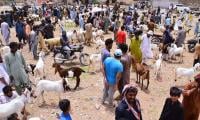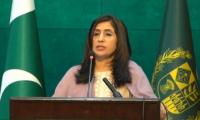Islamabad diary
Because of population and wealth, Punjab is the dominant element in the Pakistani state. Whoever commands Punjab rules Pakistan. Punjab is not without its high achievements. Bulleh Shah, Shah Hussain, and Waris Shah – to name only these three from a long list – were all from Punjab. Whether their immortal poetry has left any mark on the Punjabi mind is of course another matter.
The galaxy of verse does not end there. Among the moderns are such imperishable names as Iqbal, Faiz, Munir Niazi, Sahir Ludhianvi, and others too numerous to be named. In the world of immortal song and music we have Kundan Lal Saigal, Muhammad Rafi, Noor Jahan, Suraiya, Shamshad Begum, Ustad Bade Ghulam Ali Khan, Madan Mohan, etc.
Saigal and Rafi in their field, and Iqbal and Faiz in theirs, were pioneers who set out new paths for others to follow. Punjab, however, has produced few path-breakers in the political field except perhaps for the unforgettable Sardar Bhagat Singh, the great freedom fighter whose statue if we had any sense of history would stand in Shadman Chowk near where he was hanged by the British.
To sum up, the problem lies not with Punjab’s poetic or artistic legacy. Punjab’s place in that constellation is assured. The problem lies with its history. For all the abundance of genius in other fields, Punjab gave birth to no great kings or captains of armies, with the one, solitary exception of Maharaja Ranjit Singh Sukerchakia of Gujranwala, later of course founder of the first and last Sikh kingdom. The rest is a blank.
Geography decreed that every invader with his mind fixed on the conquest of Delhi should first stop in Lahore. Marauding armies came and marched through Punjab on their way to Delhi and the rich plains beyond, meeting little resistance in the land of the five rivers or its capital, Lahore…this city of a thousand tales, steeped in romance and the promise of hidden pleasures, like an obliging mistress repelling no one and opening its arms to everyone who stood before its walls.
Multan, considered by most thorough-bred Punjabis to be a soft and decadent city, put up some resistance to Alexander. On its walls the world-conqueror was wounded which so enraged the Macedonians that they carried out a general massacre in the town. Multan resisted the British too and it was only after a tight battle that the city fell to them.
Lahore’s fame in history rests on other things: the extent and splendour of its gardens, the waters of the Ravi which gave a balmy air to the city, and the storied charms of its dancing girls. It is among the achievements of the Islamic Republic that the gardens of the city have shrunk, the waters of the Ravi are now irredeemably dirty – making it impossible for any latter-day Master Madan (not to be confused with Madan Mohan) to sing “Ravi de parle kande ve mitra, wasda ai dil da chor” (check it out on YouTube) – and in the legendary singing and entertainment quarter of the city are now mostly to be found dreary little shops selling khussas and other forms of footwear.
No great city with any sense of its past destroys its entertainment districts the way our great and good ones have managed to do with the streets around the Badshahi Mosque where lay, for centuries, the singing and dancing quarter visited by high and low alike.
No Siege of Leningrad ever took place around Lahore and for that matter none around the fabled capital of Hindustan, Delhi. The two cities had this in common: greeting with fawning courtesy any invader who came along to ravish them.
In this long saga of ready surrender and capitulation Ranjit Singh is the only figure we find who was adept at the use of arms. He brought the various Sikh misls (call them factions) together, forging a strong kingdom out of them. Unlettered as he was, he had the sense not to clash with the East India Company, quick to realise that its fighting strength was greater than his own. But the British also had the good sense not to cast covetous eyes on his kingdom as long as he lived. They too had the measure of their adversary.
But even as the Maharaja kept his peace with the British he expanded his kingdom into Kashmir where Gulab Singh, appointed the ruler by him, paid him annual tribute, and westwards where by defeating the Afghans near Nowshera he went on to capture Peshawar. When the British annexed Punjab after the Maharaja’s death, they inherited his kingdom and its extended frontiers…meaning thereby that but for Ranjit Singh, Peshawar, the tribal areas and the Durand Line would not form part of our inheritance. At the bar of history we owe the Sikh warrior-king this debt of gratitude.
The lines of Partition were so drawn that while East Bengal lay a thousand miles away, in what was West Pakistan the dominant element was Punjab. East Pakistan had a slight edge in terms of population but power was in the hands of the Punjabi and Urdu-speaking-dominated bureaucracy and military, with the Punjabi feudal class playing loyal second fiddle to a coalition which came to shape the ideology and thinking of the new state. The intellectual inspiration for this coalition came principally from Urdu-speaking migrants from India, inheritors of the culture of Delhi, Lucknow, Bhopal and Hyderabad Deccan.
Pakistan quickly aligning itself with the West and becoming front-ranking member of American-led military alliances, the injection of heavy doses of religion into the national discourse, and the patronising behaviour, little short of a colonial attitude, towards East Pakistan all flowed from the biases and ideological orientation of this ruling coalition.
The Punjabi element already strong in the ruling echelons of the state became still more dominant and powerful after the separation of East Pakistan. The Zia regime had a compelling interest in developing a counterpoint to the Pakistan People’s Party with which it was virtually at war after Zulfikar Ali Bhutto’s ouster and hanging. Looking around for likely partisans it picked and groomed a cast of characters whose apotheosis we can witness in the form of the ruling PML-N leadership.
It truly represents Punjab in that it exemplifies more perfectly than anything else can the limited political imagination and equally limited historical sense of this most powerful of Pakistan’s constituent provinces.
In various forms and incarnations this leadership has been in power for the last 30 years. It can remain in power for the next 30 years and its leading lights will still be playing the only repertoire with which they are familiar: tape-cutting, over-the-top rhetoric often with little relation to reality, and putting more and more, through whatever means available, into their already burgeoning treasure chests.
With such helmsmen Pakistan can never become a modern republic, where science, technology and rational thinking hold sway and where the state takes as its first duty the education and uplift of its citizens. This is what makes the Panama case so important. More than an ordinary case, it is an opportunity to turn around the country’s fortunes by breaking the stranglehold of Punjabi mediocrity and the limitations that come from it.
Email: bhagwal63@gmail.com
People stand in line up as election officials check their ballot papers during voting general election at a polling...
Women show their voter identity cards as they stand in a queue before casting their votes in Agartala. — PTIThe 18th...
Former prime minister Imran Khan. — Instagram/ imrankhan.ptiAn old saying has it that “when you dance with the...
Kashmiris in Indian illegally occupied Kashmir protesting against the Indian occupation as the forces of India looked...
A representational image showing residents walking at a wholesale market in Karachi. — AFP/FileOnce again there is...
A representational image showing late Pakistani human rights activist and Supreme Court lawyer Asma Jahangir. —...







